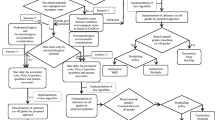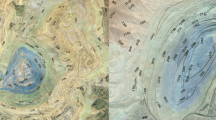Abstract
Influence of the economic criterion, called Profit, on the ranking of copper concentrates is investigated. Values of the criterion, which correspond to alternatives, are derived as earning values obtained by the exploitation of individual concentrates. Various scenarios with respect to the weight w 14, corresponding to the additional economical criterion, are defined and solved. A discrete set of results is generated, applying DECISION LAB software implementation of the PROMETHEE-GAIA methodology. Interpolating these results, we derived continuous interpolation functions which compute necessary quantities of concentrates for each real value of w 14 within the interval [0, 100].


Similar content being viewed by others
References
Al-Rashdan, D., Al-Kloub, B., Dean, A., & Al-Shemmeri, T. (1999). Environmental impact assessment and ranking the environmental projects in Jordan. European Journal of Operational Research, 118, 30–45.
Al-Shiekh Khalil, W., Goonetilleke, A., Kokot, S., & Carroll, S. (2004). Use of chemometrics methods and multicriteria decision-making for site selection for sustainable on-site sewage effluent disposal. Analytica Chimica Acta, 506, 41–56.
Aznar, J. C., Richer-Lafleche, M., & Cluis, D. (2008). Metal contamination in the lichen Alectoria sarmentosa near the copper smelter of Murdochville, Quebec. Environmental Pollution, 156(1), 76–81.
Biswas, A. K., & Devenport, W. G. (2002). Extractive metallurgy of copper. New York: Pergamon.
Brans, J. P, & Mareschal, B. (1992). Promethee-V—MCMD problems with segmentation constraints. Information Systems and Operations Research, 30(2), 85–96.
Dimitrijević, M., Kostov, A., Tasić, V., & Milosević, N. (2009). Influence of pyrometallurgical copper production on the environment. Journal of Hazardous Materials, 164, 892–899.
Djordjević, P., Mihajlović, I., & Živković, Ž. (2010). Comparasion of linear and nonlinear statistics metods applied in industrial process modeling procedure. Serbian Journal of Management, 5(2), 189–198.
Djurić, I., Djordjević, P., Mihajlović, I., Nikolic, Dj., & Živkovic, Ž. (2010). Prediction of Al2O3 leaching recovery in the Bayer process using statistical multilinear regression analysis. Journal Of Mining And Metallurgy, Section B: Metallurgy, 46(2)B, 161–169.
EU, 1999/30/CE (1999). Council directive relating to limit values for sulphur dioxide, nitrogen dioxide and oxide of nitrogen, particulate matter and lead in ambient air. The Council of the European Union.
EU, 2004/107/CE (2004). Council directive relating to arsenic, cadmium, mercury, nickel and polycyclic aromatic hydrocarbons in ambient air. The Council of the European Union.
Faitondjiev, L., Stanislavova, L., Tchuldjian, H., Gupta, S. K., & Schulin, R. (2000). Toxic elements in soils of the region of Kremikovtzi. Soil Science, Agrochemistry and Ecology, 35(5), 3–9.
Filippou, D., German, P. St., & Grammatikopolus T. (2007). Recovery of metal values from copper–arsenic minerals and other related resources. Mineral Processing & Extractive Metallurgy Review, 28, 247–298.
Franzin, W. G., McFarlane, G. A., & Lutz, A. (1979). Atmospheric fallout in the vicinity of a bade metal smelter at Flin Flon Manitoba, Canada. Environmental Science & Technology, 13(12), 1513–1522.
Gidhagen, L., Kahelin, H., Schmidt-Thome, P., & Johansson, C. (2002). Anthropogenic and natural levels of arsenic in PM10 in Central and Northern Chile. Atmospheric Environment, 36(23), 3803–3817.
Guo, B. H., & Yen, W. T. (2005). Selective flotation of enargite by electrochemical control. Minerals Engineering, 18(6), 605–612.
Habachi, F. (2007). Copper metallurgy at the crossroads. Journal of Mining and Metallurgy Section B: Metallurgy, 43(1)B, 1–19.
Hedberg, E., Gidhagen, L., & Johansson, C. (2005). Source contributions to PM10 and arsenic concentrations in central Chile using positive matrix factorization. Atmospheric Environment, 39(3), 549–561.
King, G. M. (2007). The evolution of technology for extractive metallurgy over the last 50 years—Is the best yet to Come?. Journal of Metals, 59(2), 21–27.
Lim, Mc. C. H., Ayoko, G. A., & Morawska, L. (2005). Characterization of elemental and polycyclic aromatic hydrocarbon compositions of urban air in Brisbane. Atmospheric Environment, 39, 463–476.
Lim, Mc. C. H., Ayoko, G. A., Morawska, L., Ristovski, Z. D., Jayaratne, E. R., & Kokot, S. (2006). A comparative study of the elemental composition of the exhaust emissions of cars powered by liquefied petroleum gas and unleaded petrol. Atmospheric Environment, 40, 3111–3122.
Magaeva, S., Patronov, G., Lenchev, A., & Granchorov, I. (2000). Energy analysis of processing SO 2 containing gases in metallurgy into sulphuric acind and sulphur. Journal of Mining and Metallurgy, Section B: Metallurgy, 36(1–2)B, 77–92.
Moldovanska, N., Dimitrov, R., & Ladev, L. (2000). Kinetic study of CdS oxidation process in non-isothermal conditions. Journal of Mining and Metallurgy, Section B: Metallurgy, 36(1–2)B, 103–110.
Nikolić, Dj., Jovanović, I., Mihajlović, I., & Živković, Ž. (2009). Multi-criteria ranking of copper concentrates according to their quality—An element of environmental management in the vicinity of copper-smelting complex in Bor, Serbia. Journal of Environmental Management, 91, 509–515.
Rousis, K., Moustakas, K., Malamis, S., Papadopoulos, A., & Loizidou, M. (2008). Multi-criteria analysis for the determination of the best WEEE management scenario in Cyprus. Waste Management, 28, 1941–1954.
Štrbac, N., Živković, Ž., Živković, D., Grujičić, D., & Boyanov, B. (2001). Thermal analysis of oxidation process of antimony and gallium sulphides. Journal of Mining and Metallurgy, Section B: Metallurgy, 37(1–2)B, 49–56.
Visual Decision Inc. (2007). Getting started guide, Decision Lab 2000 (executive edition). Montreal, Quebec, Canada.
WHO—World Health Organization (2001). Air quality guidelines for Europe (2nd edition WHO regional publications). Copenhagen: Regional Office for Europe.
Wolfram, S. (2003). The MATHEMATICA book (5th ed.). Champaign: Wolfram Media/Cambridge University Press.
Živković, Ž., Mitevska, N., Mihajlović, I., Nikolić, Dj. (2009). The influence of the silicate slag composition on copper losses during smelting of the sulfide concentrates. Journal of Mining and Metallurgy, Section B: Metallurgy, 45(1)B, 23–34.
Author information
Authors and Affiliations
Corresponding author
Additional information
The authors gratefully acknowledge support from the Research Projects TR34023 and 174013 of the Serbian Ministry of Education and Science.
Appendix: Implementation in MATHEMATICA
Appendix: Implementation in MATHEMATICA
In the appendix, we describe the MATHEMATICA code for computing values E i . List P defines the percentages for all 14 products (the 14th product is the “miscellaneous” group) in 14 separate concentrates.
P={{12.62,0.018,0.0340,10.71,0.19,0.52,0.0025,0.0086,
0.00003,0.004990,0.008,0.002192,0.000308,75.88},
{16.21,0.021,0.0029,37.73,0.01,0.10,0.0025,0.0140,
0.00001,0.004991,0.012,0.001234,0.000132,45.89},
{14.59,0.024,0.0057,28.72,0.14,0.40,0.0025,0.0110,
0.00002,0.004990,0.010,0.003300,0.000460,56.09},
{25.87,0.018,0.0070,33.86,0.13,0.21,0.0025,0.0200,
0.00002,0.004990,0.002,0.003350,0.000572,39.87},
{21.45,0.021,0.0180,26.16,0.32,0.42,0.0050,0.0190,
0.00003,0.004991,0.003,0.006350,0.000420,51.57},
{21.72,0.018,0.9000,33.20,0.13,0.21,0.0030,0.0080,
0.00005,0.005000,0.008,0.002510,0.000650,43.79},
{23.51,0.016,1.2000,34.50,0.85,0.85,0.0250,0.0200,
0.00009,0.004000,0.003,0.004520,0.001020,39.02},
{24.21,0.030,0.8000,36.50,1.50,2.10,0.0300,0.0100,
0.00008,0.008000,0.005,0.003850,0.000810,34.80},
{19.15,0.060,0.0100,25.20,0.55,0.35,0.0020,0.0400,
0.00020,0.005000,0.007,0.006510,0.000320,54.62},
{21.32,0.030,0.3000,31.20,1.32,1.80,0.0020,0.0350,
0.00010,0.004000,0.210,0.008230,0.000810,43.77},
{17.50,0.015,0.2500,18.50,0.85,1.10,0.0150,0.0250,
0.00009,0.005000,0.150,0.002510,0.000920,61.59},
{25.20,0.017,0.0100,38.50,0.01,0.10,0.0025,0.0100,
0.00020,0.006000,0.002,0.003320,0.000730,36.14},
{22.30,0.040,0.0700,35.30,0.08,0.20,0.0020,0.0200,
0.00009,0.006000,0.003,0.002810,0.000850,41.98},
{20.18,0.025,0.0100,33.20,1.20,0.95,0.0450,0.0300,
0.00009,0.007000,0.004,0.003820,0.000450,44.34}}/100
The list s defines the selling prices of the products.
When all necessary parameters are defined, it is possible to calculate values E i , i = 1, ..., 14. To achieve this goal, it is necessary to perform the following steps A and B:
-
Step A.
Calculate the costs of the concentrates according to Eq. 2.4:
$$ c = Table[s[[1]]*0.96*P[[i, 1]] - 400, {i, m}] $$ -
Step B.
Generate the list Profit = {E 1,...,E 14}:
$$\begin{array}{rll} EV &=& Table[s[[1]]*0.92*P[[i, 1]]+s[[12]]*0.92*P[[i,12]] \\&&\quad+s[[13]]*0.92*P[[i,13]] -c[[i]], {i,n}] \end{array}$$
Rights and permissions
About this article
Cite this article
Jovanović, I., Stanimirović, P. & Živković, Ž. Environmental and Economic Criteria in Ranking of Copper Concentrates. Environ Model Assess 18, 73–83 (2013). https://doi.org/10.1007/s10666-012-9327-1
Received:
Accepted:
Published:
Issue Date:
DOI: https://doi.org/10.1007/s10666-012-9327-1




